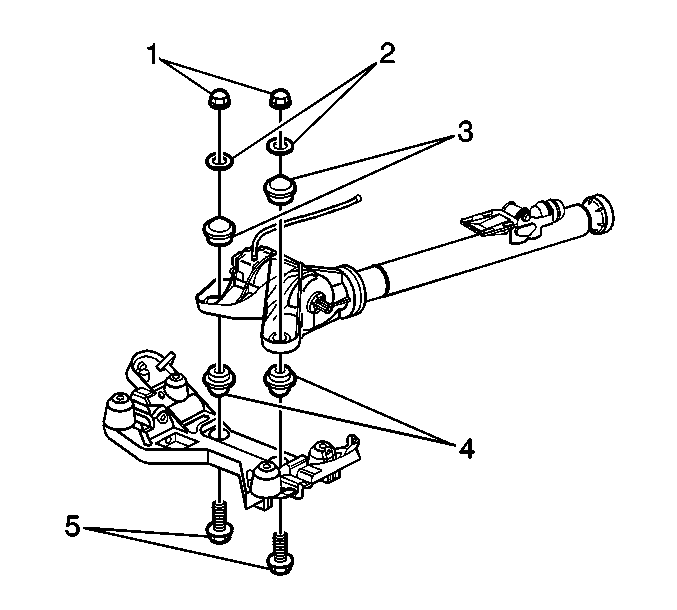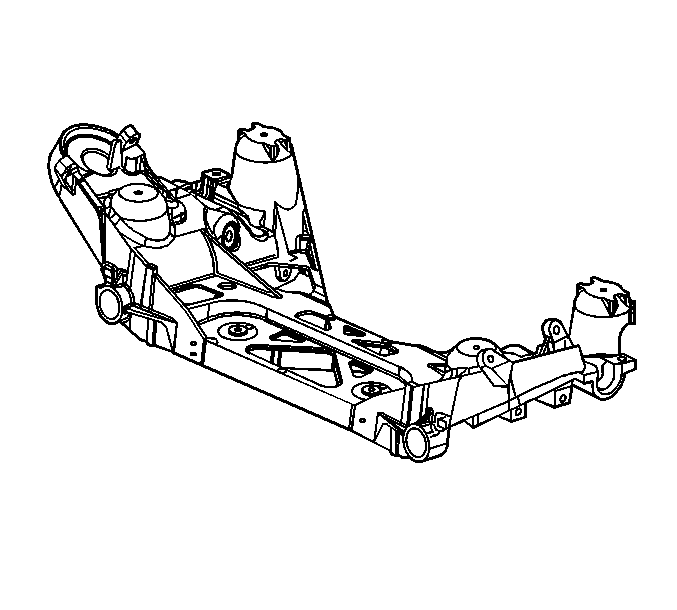Removal Procedure
- Raise and support the vehicle. Refer to Lifting and Jacking the Vehicle in General Information.
- Remove the tire and the wheel. Refer to Tire and Wheel Removal and Installation in Tires and Wheels.
- Support rear differential carrier using utility stand.
- Remove the rear differential carrier mounting bolts (5) from the rear crossmember. Refer to Differential Replacement in Rear Drive Axle.
- Remove the rear suspension knuckle. Refer to Knuckle Replacement .
- On A.W.D. models remove the wheel drive shafts. Refer to Rear Wheel Drive Shaft Replacement .
- Disconnect the wheel speed sensor harness from the lower control arm and from the rear cross member.
- Remove the rivets that attach the park brake cable to the rear crossmember.
- Remove the ALC height sensor and link. Refer to Automatic Level Control Sensor Replacement .
- Remove the ALC ball stud. Refer to Automatic Level Control Sensor Link Ball Stud Replacement .
- Secure the ALC wiring harness out of the way.
- Using a utility jack, support the rear crossmember.
- Scribe the rear crossmember mounting points to the frame.
- Remove the rear crossmember mounting bolts.
- Lower the rear crossmember.
- Remove the rear stabilizer shaft. Refer to Stabilizer Shaft Replacement (All Wheel Drive).
- Remove the rear axle upper control arms from the rear crossmember. Refer to Rear Axle Upper Control Arm Replacement .
- Remove the rear axle lower control arms from the rear crossmember. Refer to Rear Axle Lower Control Arm Replacement .
- Remove the tie rods from the rear crossmember. Refer to Tie Rod Replacement .


Installation Procedure
- Install the tie rods to the crossmember. Refer to Tie Rod Replacement .
- Install the rear axle lower control arms onto the rear crossmember. Refer to Rear Axle Lower Control Arm Replacement .
- Install the rear axle upper control arms onto the rear crossmember. Refer to Rear Axle Upper Control Arm Replacement .
- Install the rear stabilizer shaft onto the rear crossmember. Refer to Stabilizer Shaft Replacement (All Wheel Drive).
- Raise the rear crossmember, and align the rear crossmember with the scribe marks on the frame.
- Install the rear crossmember mounting bolts.
- Tighten the mounting bolts.
- Install the ALC height sensor onto the vehicle. Refer to Automatic Level Control Sensor Replacement .
- Install the ALC ball stud to the vehicle. Refer to Automatic Level Control Sensor Link Ball Stud Replacement .
- Install the rear differential carrier mounting bolts (5). Refer to Differential Replacement in Rear Drive Axle.
- Attach the parking brake cable onto the rear crossmember.
- Connect the wheel speed sensor harness onto the rear crossmember and the lower control arm.
- On A.W.D. models install the wheel drive shafts. Refer to Rear Wheel Drive Shaft Replacement .
- Install the rear suspension knuckle. Refer to Knuckle Replacement .
- Install the tire and the wheel. Refer to Tire and Wheel Removal and Installation in Tires and Wheels.
- Inspect the rear camber and toe angles and adjust as necessary. Refer to Rear Camber Adjustment and Rear Toe Adjustment in Wheel Alignment.
- Lower the vehicle. Refer to Lifting and Jacking the Vehicle in General Information.

Notice: Use the correct fastener in the correct location. Replacement fasteners must be the correct part number for that application. Fasteners requiring replacement or fasteners requiring the use of thread locking compound or sealant are identified in the service procedure. Do not use paints, lubricants, or corrosion inhibitors on fasteners or fastener joint surfaces unless specified. These coatings affect fastener torque and joint clamping force and may damage the fastener. Use the correct tightening sequence and specifications when installing fasteners in order to avoid damage to parts and systems.
Tighten
Tighten the rear crossmember mounting bolts to 115-145 N·m
(96 lb ft) .

Tighten
Tighten the rear differential carrier mounting bolts to 37 N·m
(50 lb ft).
